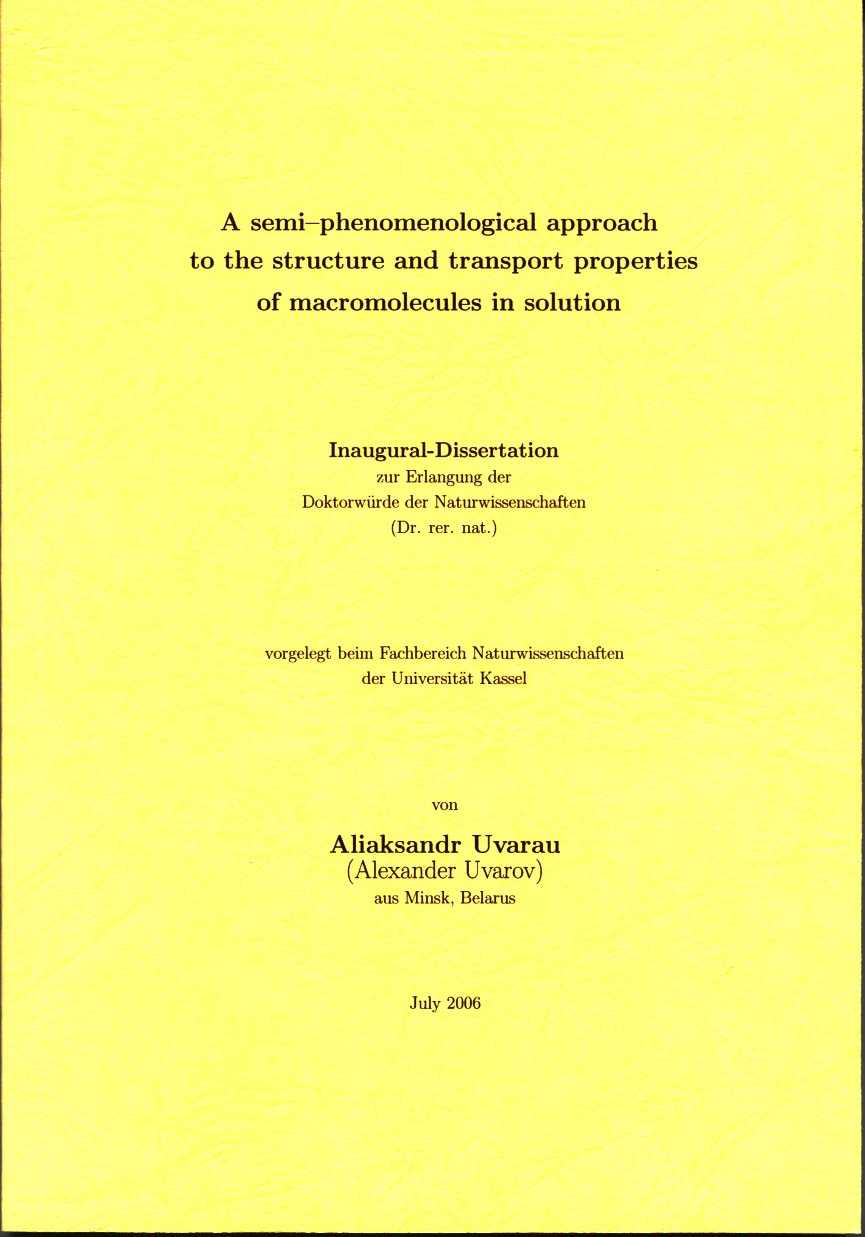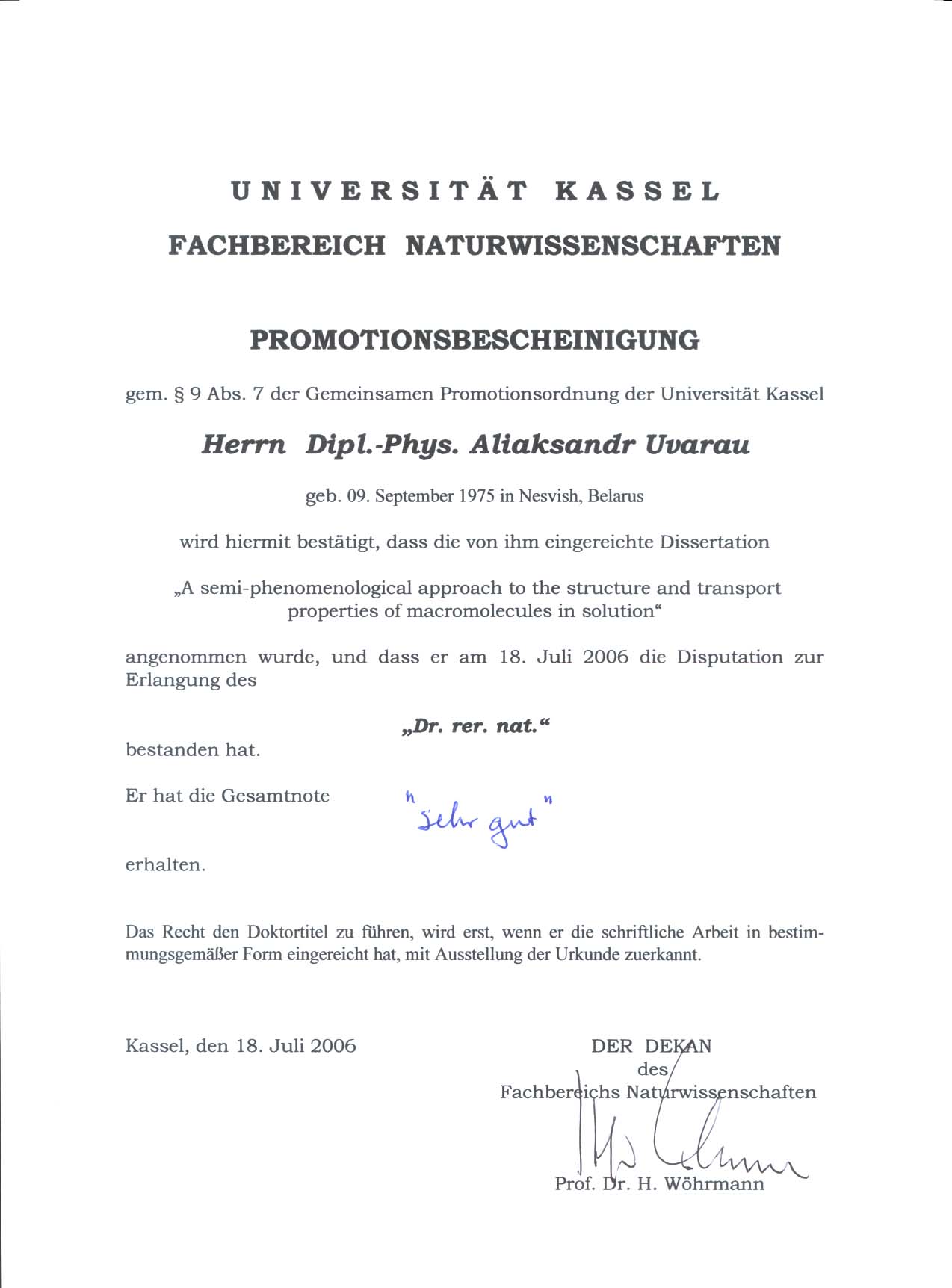The
thesis have been published online
in the Kasseler Online Bibliothek Repository & Archiv (KOBRA)


|
|
 Abstract Abstract
|
Being
very important in life, the macromolecules are the point of interest of
a lot of disciplines including biophysics, chemical physics, material
science, etc. During the last few years, therefore, a novel semi--phenomenological approach has been developed starting
from the microscopic view point on the system 'macromolecule+solvent'
and using the Hamiltonian mechanics as well as the master equations for
the phase--space distribution functions of the macromolecules. Since
then, the phenomenological approach has been employed very succesfully
to investigate the structure and transport properties of macromolecules
in solution. Within the framework of the semi--phenomenological
approach, in particular, (i) the role of the macromolecule--solvent
interaction on the translational motion of macromolecules in solution
as well as (ii) the diffusion properties of the various macromolecules
have been investigated for different thermodynamic regimes of the
solvent. Apart our investigations in the translational motion of the
macromolecules in solution, however, (iii) the properties of the
rotational (orientational) motion of macromolecules, which is
immobilized on a surface, have been also studied with respect to the
various intermolecule and macromolecule--surface interactions.
Compared with
often expensive MD calculations, a great gain in efficiency is obtained
by several orders
of magnitude and may thus
allow investigations on more complex systems for which other numerical
techniques will remain unfeasible in the near future. Special attention
of this thesis work, moreover, was placed on the flexibility of our
approach which makes it possible to implement future investigations in
the field of the macromolecular solution.
Keywords: bead, diffusion, Fokker--Planck
equation, friction, hydrodynamic interaction, macromolecules,
transport.
 Zusammenfassende Zusammenfassende
|
Motiviert
durch die Lebenswissenschaften (Life sciences)haben sich Untersuchungen zur Dynamik
von Makromolekülen in Lösungen in den vergangenen Jahren zu einem
zukunfts\-weisenden Forschungsgebiet etabliert, dessen
Anwendungen von der Biophysik über die physikalische Chemie bis hin zu
den Materialwissenschaften reichen. Neben zahlreichen experimentellen
Forschungsprogrammen zur räumlichen Struktur und den
Transporteigenschaften grosser Moleküle, wie sie heute praktisch an
allen (Synchrotron--) Strahlungsquellen und den Laboren der Biophysik
anzutreffen sind, werden gegenwärtig daher auch umfangreiche
theoretische Anstrengungen unternommen, um das Diffusions\-verhalten
von Makromolekülen besser zu erklären.
Um neue Wege für
eine quantitative Vorhersagen des Translations--
und Rotationsverhaltens grosser Moleküle zu erkunden, wurde in dieser
Arbeit ein semi--phänomenologischer Ansatz verfolgt. Dieser Ansatz
erlaubte es, ausgehend von der Hamiltonschen Mechanik des Gesamtsystems
`Molekül + Lösung', eine Mastergleichung für die Phasenraumdichte der
Makromolek\"u{}le herzuleiten, die den Einfluss der Lösung mittels
effektiver Reibungstensoren erfasst. Im Rahmen dieses Ansatzes gelingt
es z.B. (i) sowohl den Einfluss der Wechselwirkung zwischen den
makromolekularen Gruppen (den sogenannten molekularen beads) und den Lösungsteilchen zu
analysieren als auch (ii) die Diffusionseigenschaften für veschiedene
thermodynamische Umgebungen zu untersuchen. Ferner gelang es auf der
Basis dieser Näherung, die Rotationsbewegung von grossen Molekülen zu
beschreiben, die einseitig auf einer Oberfläche festgeheftet sind.
Im Vergleich zu
den aufwendigen molekulardynamischen (MD) Simulationen grosser
Moleküle zeichnet sich die hier dargestellte Methode vor allem durch
ihren hohen `Effizienzgewinn' aus, der für komplexe Systeme leicht mehr
als fünf Grössenordnungen betragen kann.
Dieser Gewinn an
Rechenzeit erlaubt bspw. Anwendungen, wie sie mit MD Simulationen wohl
auch zukünftig nicht oder nur sehr zögerlich aufgegriffen werden
können. Denkbare Anwendungsgebiete dieser Näherung betreffen dabei
nicht nur \textit{dichte} Lösungen, in denen auch die Wechselwirkungen
der molekularen beads zu benachbarten Makromolekülen eine
Rolle spielt, sondern auch Untersuchungen zu ionischen Flüssigkeiten
oder zur Topologie grosser Moleküle.
Keywords: Diffusion, Fokker--Planck Gleichung,
hydrodynamische Wechselwirkung, Makromolekül, molekulare beads,
Reibung, Transporteigenschaften von Molekülen.
The
thesis have been published online
in the
Kasseler Online Bibliothek Repository & Archiv (KOBRA)
|
|
 Publications Publications |
First of all I'd like to
extend my gratitude to my supervisor Prof.
Dr. Stephan Fritzsche for all the encouragement and permanent
support during these years. He always put off a lot of time for our
discussions and his help and suggestions were very important for my
research. In addition to words, he taught me how to do science with his
example. Moreover, the friendly relations which have been settled down
between us within these year were also extremely for me.
I also
want to thank Prof. Dr. Burkhard
Fricke for accepting me in the theoretical physic group at the
University of Kassel and for giving me unique opportunity to fulfill
this thesis work. Actually, I have really enjoyed the friendly
environment of the theoretical physic group in Kassel and would like to
thanks my past and present colleagues from the university: Dr. Wolf--Dieter Sepp, Dr. Josef Anton, Dr.
Andrey Surzikov, Dr. Ekaterina Rykhlinskaia, Dr. Peter Koval, Dr.
Thorsten Inghoff, Dr. Cristina Sarpe-Tudoran, Tomas Radtke, Lesya
Borowska as well as Larisa
Tatarinova.
A
special place of my acknowledgment I wish to reserve for the peoples
from the Institute of Molecular and Atomic Physics (Minsk, Belarus),
including Dr. Alexander
Pavlovich Blokhin, Dr. Maxim
Feliksovich Gelin and Dr. Iavn
Ivanovich Kalosha as well as, of course, Academ. Prof. Dr. Vitaliy Anatol'evich
Tolkachev. These scientists introduced me to the word of the
macromolecular physics and gave rise to my first experience of the
scientific research.
Of
course, I'd like to thank effusively both Dr. Olexander Rabinovych as well as Dr. Fedor Mayorov. Apart from being
a really good friends, these two colleagues acquainted me with many
interesting russian--kazakh--germany peoples (rusakoff and rusachek) who are far from physical
science but very attractive persons like Tatjana Rieb (I still can not to get
into the way of this surname! I guess Bezk
sounds much more better.) I also thank Tatarov's married couple:
Viktoriya [Vikusya] for the
really interested discussions and for the perfect cooking; Evgeniy [Jeka] who liberalized me in the
chemistry and the soccer. In these areas, unfortunately, my knowledge
is still far from ideal. One collective thanks to all my another friends from Kassel,
Minsk, ..., without other people even physics would be useless!
I would
like to express my very special gratefulness to both my sisters---Tanusham--- and nieces---Uliya and Katya--- for
their love. Special thanks, moreover, to the parents of my wife: Yarosh Larisa Genrikhovna [LG] and Yarosh Grigoriy Nikolaevich [GN] for their very important
support.
Finally
two special thanks. Last, and certainly not least, I must express
heartfelt gratitude to my wife Katrin
[Katusha] for her everlasting
and contagious smile. Her perseverance has been boundless, her support
selfless! My thanks also to my son
Dmitriy [Korol' and/or Zlopastiy Brandoshmig], for his
presence in my life, for the gladness which he get me all the time.
To
my family I dedicate this thesis.
Alexander Uvarov; Kassel, July 2006
|

 Personal
Data
Personal
Data Research
Research Other
Other



